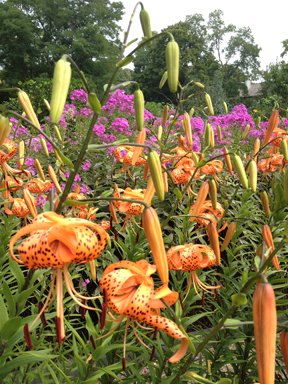Your first perception as you drive up to Fred Stelle's serene North Haven waterfront acreage is Wow, fruit trees. Pears aplenty not yet ripe. Abundant apples showing a blush, anticipating autumn. And beyond, a vintage house, a former actors' colony during the Depression, getting a bit of this architect's signature touch with a bit of construction. All he ever wanted, Stelle said addressing a group of journalists on a pre-tour visit, was to plant fruit trees. Exemplifying the challenge of this year's garden as art tour, how to accomplish gardening without the use of chemicals, he explained how he was able to live his dream against popular wisdom. Everyone told him, you cannot have fruit trees without spraying toxins. And he has spent seven years figuring out how to defy that advice. Yes, this year's tour comes with a message: as many consumers are concerned with conserving our planet, and keeping our children healthy, it starts with the soil. Of the gardens open to visitors this year, an annual benefit to Guild Hall, all are the result of chemical free planting. It was a relief to see that in the three cases visited last week, values of beauty and utility were not compromised.
Susan Dusenberry's modern home nearby is a model of respite, with unique grasses. From above, where she has a rooftop garden, the colors below form geometric patterns. The native plantings were designed to take full advantage of "the expansive views of this diminutive site," according to the brochure, but none of the artsy photos can do the artful perfection of this place justice.
At Roundhouse, adjacent to East Hampton's Long House, Judy Bergsma brought the message home. Showing a bed of lovely flowers on her ten-acre garden, she pointed out that the plantings were especially chosen to attract butterflies. In the past two years, fewer than ten monarchs were spotted hovering around the blooms. That's because of the chemicals in the Midwest, she asserted, the monarchs are being decimated. Nevertheless, we all sighed in relief to see the bees, happily sucking their juices, having a great time.
A version of this post also appears on Gossip Central.

